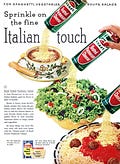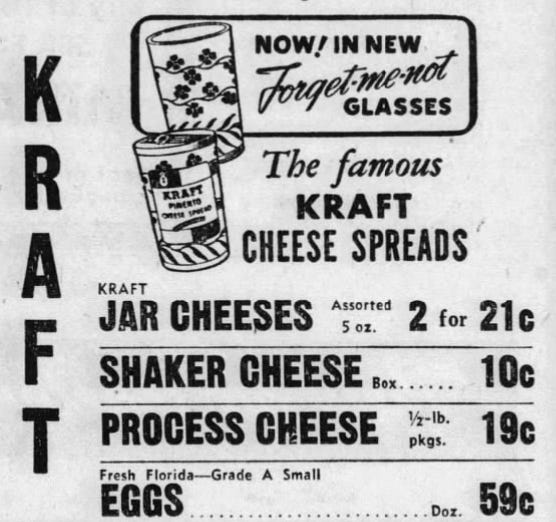We all know about soda vs. pop vs. Coke. And the many names for an elongated, overstuffed sandwich. But this week we're talking about a less well-examined food slang variation. Welcome to another Shoddy Goods, the newsletter from Meh about the stuff people make, buy, and sell. I'm Jason Toon, tying on my bib for a feast of culinary-linguistic minutiae…
My family never had spaghetti without it. We wouldn't dream of leaving it off of pizza. And we always had it on hand for mostaccioli (which we pronounced "musk-a-choli" but that's another story). I'm talking, of course, about that shiny green canister of Kraft grated Parmesan cheese.
Kraft started marketing grated Parmesan in the late 1940s. Wartime austerity was lifting. Families had more money to spend and a taste for new things. Italian cuisine was still just exotic enough to be interesting. But with Italian immigrants established in big cities for a couple of generations, and millions of GIs just back from Europe, it was also increasingly familiar. Italian food was poised to join the US mainstream and become big business - properly packaged for American tastes, of course.
Convincing Americans to grate their own blocks of hard cheese and spoon it out of little bowls might have been a hard sell. But what if "Italian" "cheese" (more on that later) was sold already grated, in a ready-to-shake canister that could stand right alongside the salt and pepper?
But not too Italian.
I haven't been able to pin down when exactly a shaker of powdery "Parmesan" (more on that later too) became a standard condiment in U.S. pizza places. I looked through a lot of vintage pizzeria photos like this one, with checkerboard-bedecked tables bereft of Parm shakers. Then by the '70s, they seemed to become so ubiquitous that they were a fixture at that great standardizer of the American pizza palate, Pizza Hut.
So I don't know if Kraft was setting a trend or co-opting one. In any case, that tall green can quickly assumed a place of honor in American kitchens. Kids especially loved it. But the strange new word "Parmesan" still seemed like a mouthful to Anglophone families. They needed a nickname for this savory new staple, something that would roll off the tongue and finish the phrase "Pass the…"
Shake, sprinkle, or stinky?
The obvious diminutive would be "Parm", and so it became in many households. But in my family in the '70s and '80s, as well as lots of others, it was always sprinkle cheese. The other common option was to use some variation on "shake", like shake cheese, shaker cheese, or shaky cheese. Smaller factions took their cue from the color of the canister (green cheese) or the pungent aroma (stinky cheese).
Unlike the well-documented slang for fizzy drinks and big sandwiches, there don't seem to be any sociological or linguistic studies about this particular colloquial divide. But who needs academia when we've got Reddit?
96 people gave answers in this Reddit thread, not counting the boring ones that are just "it's parmesan duh lol". I added them up and broke down the data, because I am a very serious journalism man. Stop the presses: shake-derived terms won a clear majority.
Shake/shaker/shaky: 55
Sprinkle/sprinkles: 22
Stink/stinky/stinky feet/feet/foot: 9
Green/green bottle/green top: 4
Dust/dusty: 2
Other: 4 (fluffy, powdered, pizza, snow)
OK, I think I love "fluffy cheese". I'm switching my allegiance and I urge my fellow sprinklers to follow suit.
A Tampa grocer speaking the people's language, 1948.
As for the geographic patterns… there aren't any. Shakers span the country from California to the New York island, while sprinklers are found from Florida to Oregon and in every region in-between. The naysayers are just as evenly distributed: time and again in that Reddit thread, somebody says something like "I'm from Indiana and everybody just calls it Parmesan", only to have another fellow-stater insist that their entire family calls it shaky cheese. It seems to be a family-by-family difference rather than a regional one.
Another recurring theme in that thread points to why. "When my kids were tiny, they started calling it Shaky Cheese, and that's what it's been in our house ever since," says one commenter, echoed by several others.
Regional slang spreads and deepens through usage in a wider community, while these bits of kidspeak start and mostly end inside the home. Whether a kid gravitates toward "shake" or "sprinkle" doesn't seem to have much to do with where they live. They're more like those little inside jokes families have, based on childhood mispronunciations and malapropisms, than locally rooted lingo like "hoagies" or "grinders".
Here's another interesting point: many respondents use these terms not because they don't know it's called Parmesan, but to differentiate it from the good stuff. "I use 'shaky cheese' to distinguish between that bad Kraft parmesan that comes in the green container and better/real parmesan," one Redditor says. Contrary to the sniffy dismissal that these terms are only for people who don't know what real Parmesan is, they're often used to make exactly that distinction.
And that brings us to a tangent we can't avoid: whether "Kraft 100% Grated Parmesan" is really Parmesan, or if it even qualifies as cheese at all.
The grate debate
A certain percentage of you have been smoldering through this entire piece, wisps of smoke wafting from your ears, increasingly enraged that Big Dairy has hoodwinked the public into believing that this powdered industrial substance has anything whatsoever to do with the noble 800-year-old tradition of Parmigiano Reggiano, king of cheeses.
Yeah, you've got a point. Under EU law, "Parmesan" can only be used to refer to Parmigiano Reggiano, which must be made in a handful of Italian provinces, under a strictly defined process that includes at least 12 months of aging. Parmigiano Reggiano is sold in wheels that bear an official seal of authenticity and an individual serial number for each wheel.
Elsewhere, the guidelines for Parmesan are much more lax. US regulations only require Parmesan to be aged for 10 months and meet certain levels of fat and water content. That means that when American manufacturers want to sell their "Parmesan" in Europe, they have to use another name: in Kraft's case, they call it "Pamesello".
Emphasis on the "sell".
US law also allows Parmesan to be sold shredded or grated, including up to 4% cellulose powder as an anticaking agent. That has given rise to another persistent claim about mass-market grated Parmesan: that it contains "wood chips" or "sawdust".
"The Parmesan Cheese You Sprinkle on Your Penne Could Be Wood" reads one such headline from Bloomberg. It's absolutely true that some manufacturers have been busted by the FDA for adulterating their grated Parmesan beyond the level allowed by law, either with other cheeses or cellulose powder.
But cellulose powder itself is hardly "sawdust" or "wood pulp". It's a harmless additive that can be made from pretty much any otherwise indigestible plant matter, not something they sweep up off the floor at the lumber mill. In commercial food production, cellulose powder is widely used to make cheap food seem less cheap, and fattening food less fattening.
"It has certain physical properties that allow manufacturers to cut out other ingredients to make things like pancake syrup or low-fat cookies or low-fat ice-creams that have the mouthfeel of ice-creams with regular levels of fat," food writer Jeff Potter told Bon Appétit.
So yes, cellulose powder is definitely not cheese - which seems to me like reason enough to object to excessive levels of it in so-called "Parmesan" without flying into wild hyperbole about it being "sawdust".
Let's be honest, though: you don't shake - or sprinkle - granular Parm onto your pizza and pasta because it's objectively "good", like a hearty, complex wedge of Parmigiano Reggiano. You do it because it scratches a certain junk-food itch. Or because your kids like it. Or because after years of eating it, a big New York-style slice doesn't taste right without it.
So even though Americans know a lot more about good food than the long-ago first buyers of those Kraft canisters, I have a feeling families will keep coining their own nicknames for cheap grated Parmesan for a long time to come.
It’s funny, we always had the green canister growing up, and yet I think I’ve never bought even one as an adult. What things did you always have in the fridge or pantry growing up that you’d never have in yours now? Chime in over in this week’s Shoddy Good’s chat and we’ll reveal our deepest, darkest, cheesiest culinary secrets.
—Dave (and the rest of Meh)
You can trust Shoddy Goods to serve you only pure, unadulterated, 100% infotainment like this (no sawdust included):




